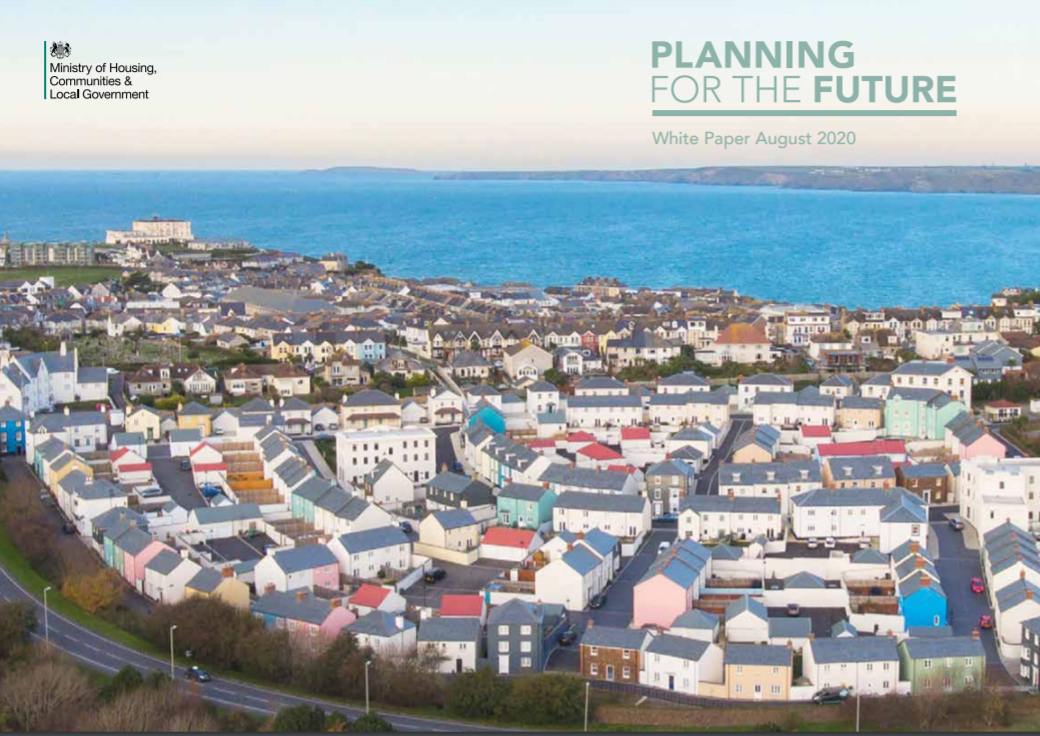Planning for the future
On 6 August 2020, the government published a consultation on reforms to the planning system. The proposals are intended to streamline the process, cut red tape, harness technology and protect green space to deliver high-quality, sustainable communities.
The white paper, Planning for the future, developed with advice from the Planning Taskforce, focusses on local community agreement, with communities consulted from the very beginning of the planning process.
Land will be designated into one of three categories decided through local consensus:
- Land suitable for growth will be approved at the same time that plans are prepared, meaning developments can be built quickly, as long as local design standards are met.
- Renewal areas will enable much quicker development where those developments are well designed in a way which reflects community preferences.
- Development on green belt land will continue to be restricted, with policy remaining a decision for local authorities.
Other proposed changes include;
- Overhauling the existing planning process and replacing it with a clearer, rules based system.
- Section 106 agreements and the Community Infrastructure Levy will be replaced with a new Infrastructure Levy that will be a fixed proportion of the value of the development, above a set threshold.
- Establishing local design guidance for developers to build and preserve beautiful communities.
- Making all new homes ‘zero carbon ready’, with no new homes needing to be retrofitted.
- Allowing for more building on brownfield land.
- Making all new streets tree lined.
- A First Homes scheme to provide newly-built homes at a 30% discount for local people, key workers and first-time buyers.
- Harnessing technology through online maps and data, to make the whole system more accessible.
- Make the housing industry more diverse by supporting SMEs and self-builders.
Housing Secretary Rt Hon Robert Jenrick MP said: “Our complex planning system has been a barrier to building the homes people need; it takes 7 years to agree local housing plans and 5 years just to get a spade in the ground. These once in a generation reforms will lay the foundations for a brighter future, providing more homes for young people and creating better quality neighbourhoods and homes across the country. We will cut red tape, but not standards, placing a higher regard on quality, design and the environment than ever before. Planning decisions will be simple and transparent, with local democracy at the heart of the process.”
Victoria Hills, chief executive of the Royal Town Planning Institute (RTPI), said: “The RTPI will judge the success of these reforms on how successfully they tackle inequality, accelerate progress to net-zero carbon emissions, promote sustainable transport and answer the need for strategic planning. It is, however, extremely encouraging to see recognition in the proposals of the importance of a local plan, quality design, community engagement and a plan-led approach."
Eddie Tuttle, director of policy, research and public affairs at the CIOB, said: “The white paper published today highlights the need for reform of the planning system in order to build the homes we desperately need. But we are concerned the government’s focus on extending permitted development rights, including the ability to demolish and rebuild commercial and residential buildings on existing sites without a full planning —if implemented without significant safeguards—will lock in more unacceptable standard development, the consequences of which we will live with for generations or must rectify later at greater expense.”
The full consultation document is available at: www.gov.uk/government/consultations/planning-for-the-future
[edit] Related articles on Designing Buildings Wiki
Featured articles and news
RTPI leader to become new CIOB Chief Executive Officer
Dr Victoria Hills MRTPI, FICE to take over after Caroline Gumble’s departure.
Social and affordable housing, a long term plan for delivery
The “Delivering a Decade of Renewal for Social and Affordable Housing” strategy sets out future path.
A change to adoptive architecture
Effects of global weather warming on architectural detailing, material choice and human interaction.
The proposed publicly owned and backed subsidiary of Homes England, to facilitate new homes.
How big is the problem and what can we do to mitigate the effects?
Overheating guidance and tools for building designers
A number of cool guides to help with the heat.
The UK's Modern Industrial Strategy: A 10 year plan
Previous consultation criticism, current key elements and general support with some persisting reservations.
Building Safety Regulator reforms
New roles, new staff and a new fast track service pave the way for a single construction regulator.
Architectural Technologist CPDs and Communications
CIAT CPD… and how you can do it!
Cooling centres and cool spaces
Managing extreme heat in cities by directing the public to places for heat stress relief and water sources.
Winter gardens: A brief history and warm variations
Extending the season with glass in different forms and terms.
Restoring Great Yarmouth's Winter Gardens
Transforming one of the least sustainable constructions imaginable.
Construction Skills Mission Board launch sector drive
Newly formed government and industry collaboration set strategy for recruiting an additional 100,000 construction workers a year.
New Architects Code comes into effect in September 2025
ARB Architects Code of Conduct and Practice available with ongoing consultation regarding guidance.
Welsh Skills Body (Medr) launches ambitious plan
The new skills body brings together funding and regulation of tertiary education and research for the devolved nation.
Paul Gandy FCIOB announced as next CIOB President
Former Tilbury Douglas CEO takes helm.
UK Infrastructure: A 10 Year Strategy. In brief with reactions
With the National Infrastructure and Service Transformation Authority (NISTA).























